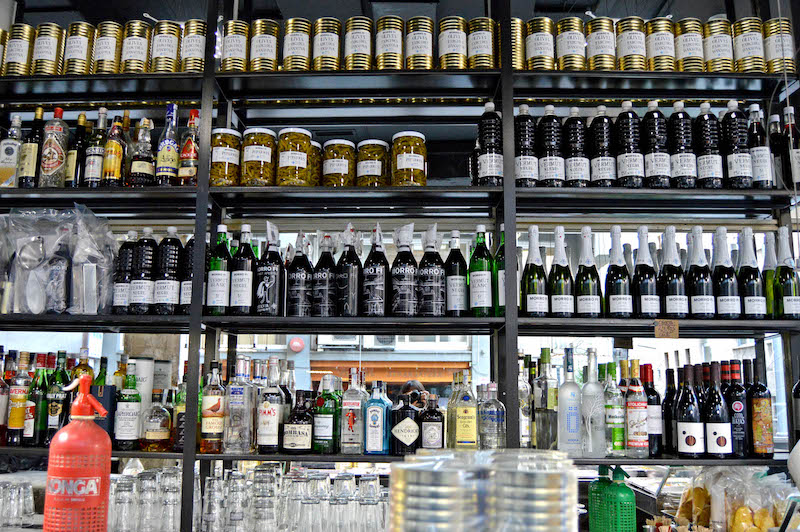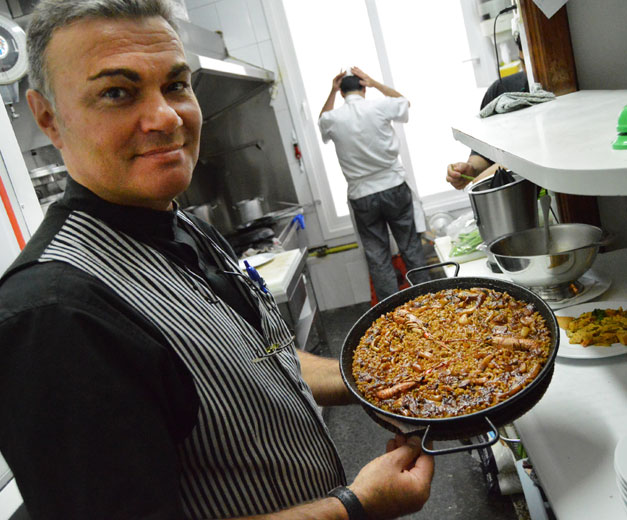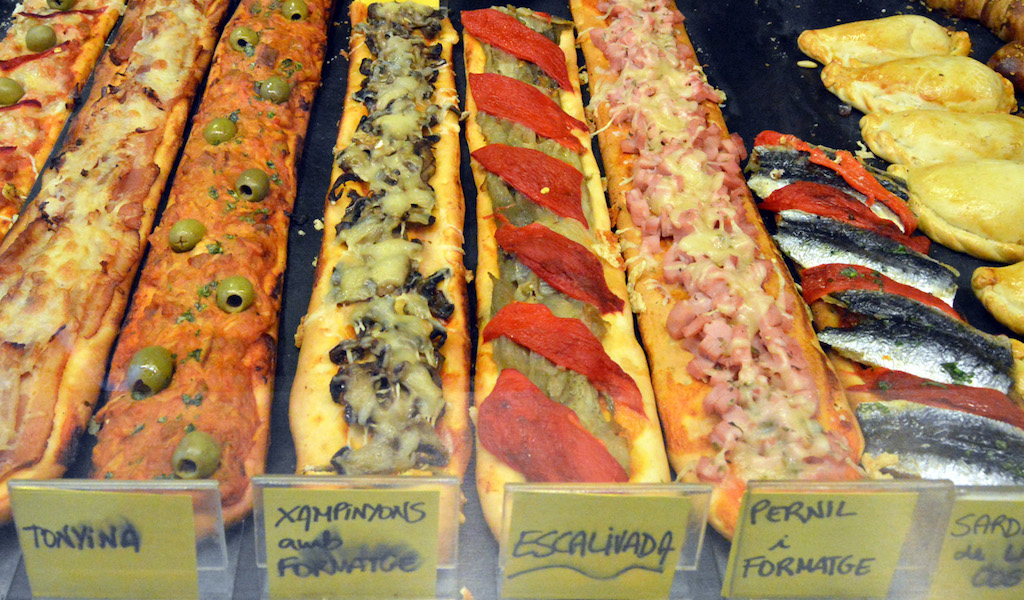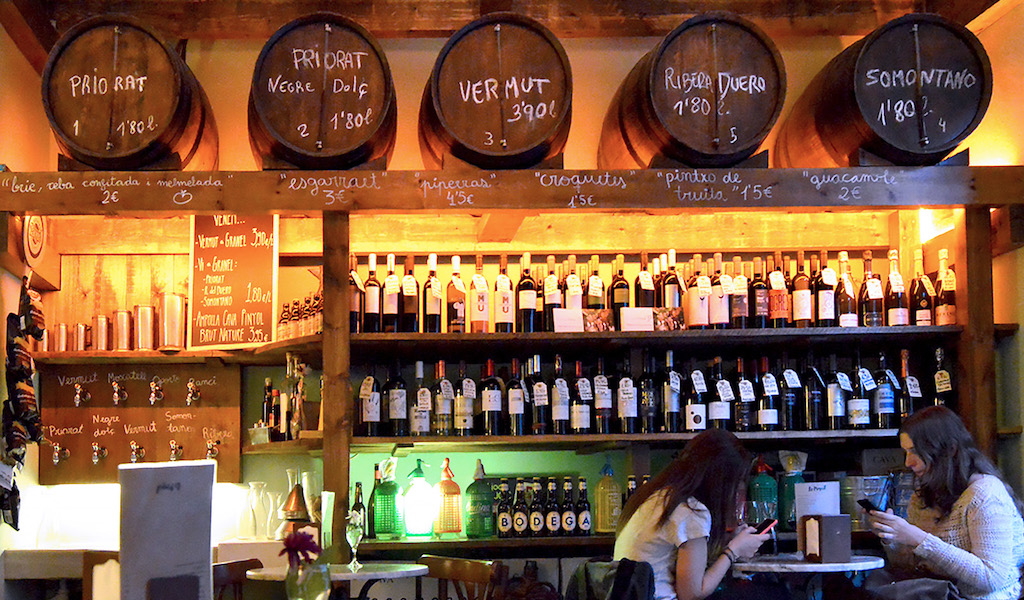We can't find the internet
Attempting to reconnect
Something went wrong!
Hang in there while we get back on track
Search results for "Paula Mourenza"
Barcelona
¡Salud!: Barcelona's Top 5 Places for Vermouth
Why are you seeing colorful, 1960s-era carbonated water siphons everywhere in Barcelona? Because they’re the symbol of our beloved vermut ritual. The phrase hacer el vermut (literally “to do the vermouth”) in Spain has for decades described not only that delicious beverage, but also any kind of pre-lunch aperitif. But since the end of the 19th century in Barcelona, the vermut ritual – a fresh drink accompanied by tapas composed usually of preserved food, cold cuts, cured or marinated fish or seafood – has been a way to bring people together before meals. Perhaps no one is more responsible for vermouth’s popularity here than Flaminio Mezzalama, the Italian Martini & Rossi representative in Spain, who in the first decade of the 20th century opened two beautiful Art Nouveau vermouth bars, which became hugely popular. Mezzalama died in Torino in 1911, but the fame of vermouth in Catalonia only grew, with local investors putting their money into production of Catalan vermut.
Read moreBarcelona
Coca de Recapte: Flat Food
Coca is a word used in Catalonia and neighboring regions for many kinds of baked doughs and pastries, both sweet and savory. The Catalan and Occitan word has the same root as “cake” and comes from the Dutch word kok, which entered the local lexicon during the reign of the Carolingians in Catalonia (759-809)
Read moreBarcelona
Lo Pinyol: Book Club
Bars and literature are like bees and flowers: two separate worlds linked to each other through a symbiotic relationship that benefits both. Writers and characters have been the natural inhabitants of taverns and pubs in Dublin and London, bohemian cafés in France, Vienna and Madrid, and, of course, the old neighborhood restaurants and bodegas of Barcelona.
Read moreBarcelona
La Ruta del Bacallà: Follow the Fish
Salt cod has been a staple on the Iberian Peninsula for centuries, but in the last few decades overfishing and changes in eating habits have resulted in a significant drop in bacallà consumption. Only recently has the fish begun returning in greater numbers to our tables, and it has also become the focal point for an annual gastronomic celebration: La Ruta del Bacallà. There’s a popular saying on the Iberian Peninsula that there is one cod recipe for every day of the year, but in truth, the number is upwards of 500. In Spain, there are hundreds of cod recipes dating from the Middle Ages, with a multitude of regional variations. The most notable and sophisticated ones come from Basque country and Catalonia.
Read moreBarcelona
Bean Week: Catalonia's Many-Splendored Beans
Known in Catalan as mongetes – “little nuns,” as Catalonia’s oldest kind of beans resemble the pale face of a nun in her black habit – or fesols, from the Latin phaseolus, beans are an integral part of the region’s culinary traditions. If Catalan home cooking could be represented by a single dish, it would be butifarra amb mongetes, peppery pork sausage which is either grilled or fried and served with a little mountain of delicious beans: simple, filling and soul-warming. But in Catalonia the number of dishes made with legumes is infinite. In fact, many local restaurants offer a choice of beans or potatoes to go with all manner of seafood or meat preparations, from chicken to pork or veal, or from cod to squid or sardines.
Read moreBarcelona
Best Bites of 2014: Barcelona
Editor’s note: The year is coming to an end, which means it’s time for us to look back on all the great eating experiences we had in 2014 and name our favorites among them. Can Pineda At this tiny, century-old restaurant in the neighborhood of El Clot, we ate a simple dish of guisantes lágrima (“tear-shaped peas”) with little bits of jamón ibérico, one of the most delicious culinary treasures we have had all year – and one we will remember for a long time to come.
Read moreBarcelona
Eat the Vote: Food and Catalan Independence
On November 9, Catalonia conducted a straw poll on independence, with more than 80 percent voting in favor of secession, and more than 10 percent voting for statehood without independence. In spite of a ruling from Spain’s Constitutional Court to suspend the vote, the regional government, under the leadership of Catalan president Artur Mas, was able to proceed with this more symbolic poll thanks to support from 40,930 volunteers. The general atmosphere was civil and calm, but the prevailing mood was clear from the numerous flags, pro-independence T-shirts and yellow signs everywhere proclaiming, “We want a new country!”
Read moreBarcelona
Mercat de Mercats: Barcelona's Market Festival
La Boquería is undoubtedly one of the most famous markets in the world, but there are 43 markets spread across Barcelona, each with its own unique charms. Once a year, they can be experienced all at the same time, in the same place. From October 17 to 19, 265,000 visitors thronged the square in front of Barcelona Cathedral for the fifth edition of the Mercat de Mercats (Market of Markets) festival, which gathered 40 stalls, 30 local artisan producers, 40 chefs with 17 Michelin stars between them and 14 of the city’s best restaurants. The festival offers an amazing opportunity for locals and tourists to taste the dazzling array of Catalan flavors and to get to know the city’s neighborhood markets.
Read moreBarcelona
Butifarring: Tubular Gastronomy
[Editor's note: we're sorry to report that Butifarring is now closed.] Gourmet fast food has swept through Spain at full speed. It comes in multiregional styles and with strong creative inspiration behind it – and, most importantly, the food itself can be exceptional.Eric Camp, Albert Gómez and their three partners are a good example of this, with their sausage-centric project, Butifarring, and their first small venue in Barrio Gòtico, which is much more than a Catalan hot dog or sandwich place.
Read moreBarcelona
CB on the Road: Madrid's New Wave Markets
On recent visits to Madrid, we’ve noticed that a new breed of food market has taken hold of the city’s attention. While the traditional kind with food stalls slowly disappears, vibrant, culture-focused gastromarkets are booming. In addition to great food, they offer a mix of businesses, along with cooking demos, live music, exhibitions – the list goes on. In 2009, the private society El Gastródomo de San Miguel refurbished a beautiful building that was built in 1916 and located very close to Plaza Mayor. It was opened as the “culinary space” Mercado de San Miguel. Though the initial inspiration was Barcelona’s La Boquería, San Miguel is utterly different, with its own colorful, unique personality. The market is dedicated not just to selling quality seasonal foods, but also to allowing visitors to enjoy them in situ, at tables and chairs distributed throughout common areas. They can choose from cod, fresh shellfish and other seafood, various vermuts, pickles and olives, paella, churros, Spanish wines, international beers, delicious Iberian ham and cured sausages and cheeses, ice cream and non-Spanish items, such as pasta or sushi. Unsurprisingly, the concept has been a hit, and other similarly styled markets have since popped up around the city.
Read moreBarcelona
Ratafía: A Midsummer's Night Drink
In Catalonia around the summer solstice, we make one of our most traditional liqueurs, ratafía, for which the herbs, fruit and flowers that are macerated in alcohol must be collected on Saint John’s Eve, or June 23. This highly aromatic digestif has long been believed to have medicinal properties. There’s even an old Catalan rhyme along those lines: Ratafía, tres o cuatro al día (“Ratafía, three or four per day”). Different versions of the liqueur have been made for centuries in eastern Spain and some regions of France and Italy but, like the other herb liqueurs throughout Europe, they originated from the Ancient Roman and Greek custom of macerating fruit and herbs in wine, from Arabian perfume distillation and from the sophisticated medieval distillations in monasteries and convents that created the first aguardientes, or grape-based, medicinal liqueurs.
Read moreBarcelona
Spanish Food Idioms: Going Full Milk
You are what you eat, as the saying goes. Is it any surprise, then, that food figures so largely in popular culture all over the world? In Spain, we have a veritable cornucopia of food-related expressions. Here’s a taste: Dar una torta, “to give a cake.” To slap someone. But darse una torta, “give a cake to yourself,” means you hit something else. It’s a mild, lighthearted expression, even with tortazo, which is a bigger biff, and comes from the funny old circus setup where a clown throws a cake into the face of another clown.
Read moreBarcelona
Bulk Wine: The Good Stuff, on Tap
For so long, bulk wine has been synonymous with plonk – even in a country like Spain, where buying wine straight from the barrel was standard practice up until the 1980s, when it was largely replaced by bottles with certified designations of origin. We are well acquainted with the bad stuff, which we call vino peleón, literally “scrappy” wine, but thankfully, the era of its ubiquity is mostly over and done with. It’s much easier these days to find good wine at low prices (€1 to €5 per liter) that’s suitable for everyday drinking. And another upside to this practice is the environmentally friendly packaging: your own jug.
Read moreBarcelona
Everyday is Fry-Day: Where We Go For the Best Churros in Barcelona
Churros, the long, skinny, crenellated, sweet fried crullers made from just flour, water and salt, have been enjoyed for centuries in Spain, with hot chocolate and without. However, in Barcelona, xurros, as they are called in Catalan, are becoming an endangered species. In recent years, more than half of the xurrerias in the city have disappeared. Many of the old-timer xurreros who still survive have the odds stacked against them: permit renewal for a street stall is near impossible; rent has become prohibitively expensive and continues to increase; or required updates to old infrastructure might prove extremely costly. However, we know of one young newcomer who has emerged with fresh energy and inspiration, incorporating lessons from the masters in his creative take on xurros. The best way to save this endangered species is to eat it, so here are our five favorite xurrerias, which make these star-shaped doughnuts with great care – and with delicious results that are worth seeking out.
Read moreBarcelona
Barcelona's Gintonics: Good to the Last Drop
Editor's note: Our third installment in the Global Bar Crawl takes us to Barcelona, where gin continues to be the drink of choice among locals. Tomorrow we head to a spot in Istanbul where you can spend an evening visiting a number of bars, all without leaving the building. Spain is a country that loves a long-drink – alcohol in combination with a soft drink, refreshing and open to invention and reinvention. On the heels of creative gastronomy’s efflorescence in recent years, many old drinks, cuisines and forgotten ingredients have returned, revived through new and more sophisticated techniques and interpretations. The gin and tonic, called gintonic here, is one such Spanish obsession, and all that ingenuity and focus have gone into taking this highball to the next level.
Read moreBarcelona
Morro Fi and Mitja Vida: The Whole Vermouth & Nothing but Vermouth
Morro Fi and Mitja Vida are two relatively new entrants to Barcelona’s vermuteo (“vermouthing”) culture, whose history stretches back to the turn of the last century. These two bars are the product of nostalgia for a bygone era fused with the social network- and urban design-driven present. The vermouth tradition in Barcelona was started in the early 20th century by Flaminio Mezzalama, who represented the Italian company Martini & Rossi in Spain, at his fabulous modernist Bar Torino. Vermut began to be produced in Catalonia, and in the following decades, the province developed its own style of the aromatic fortified drink. At the same time, the custom arose of having vermut before lunch with some pickles to whet one’s appetite. That tradition faded over time but has emerged in recent years as a kind of retro, hipster-approved pastime.
Read moreBarcelona
Can Ros: Put a Fork in It
Fried pig’s ears fortified with garlic and parsley, veal cheek and tongue laced with vinaigrette, hefty veal and pork meatballs, creamy artichoke or eggplant omelets or a hearty bocadillo of marinated tuna, red pepper, anchovies and olives: these esmorzars de forquilla, or “fork breakfasts,” are how a Catalonian might start his day – especially at Can Ros, a tapas-and-bocadillos joint that’s open every day from 7 a.m. until midnight. Office workers might drop by for a coffee at mid-morning, followed by the lunch crowd, which takes over from 2 p.m. to 4 p.m. Dinner, of course, lasts well into the night. It’s breakfast, however, that has made Can Ros most popular among locals.
Read moreBarcelona
Cava: A Toast to Spain's All-Day Sparkler
An indispensable part of celebrations, cava, the Spanish sparkling wine, is just the drink for ringing in the New Year – though we’re happy to find other reasons to raise a glass of the stuff any day of the week. Cava is produced using the same méthode traditionnelle that is used for French champagne: after the base wine is fermented from the pressing, it’s bottled, usually with a mixture of sugar and yeast, to undergo a second fermentation to produce that festive fizz.
Read moreBarcelona
El Passadís del Pep: Simple Pleasures
A hidden culinary sanctuary, El Passadís del Pep may be located in one of the most visited quarters of Barcelona, but it’s out of sight of anyone who isn’t looking for it. Once you go down the long corridor that leads to the restaurant, you don’t need to do anything, and that includes choosing what to eat. From the moment you sit down, the “house” offers you your first bottle of cava, and the celebration of food and life begins. There is no menu and there are no “daily specials,” just whatever Joan Manubens and his team decide to cook that day.
Read moreBarcelona
Best Bites 2013: Barcelona
Editor’s note: This post is the second installment of “Best Bites of 2013,” a roundup of our top culinary experiences over the last year. Stay tuned for “Best Bites” from all of the cities Culinary Backstreets covers. Forn Baluard We started the year off heating our hands near the wood-fired oven at Forn Baluard, one of Barcelona’s top bakeries. It hasn’t been around long, but it has decades of experience in its DNA, as it’s headed up by Anna Bellsolà, a fourth-generation baker.
Read moreBarcelona
Turrón: Have Yourself a Chewy Little Christmas
Typically eaten at Christmastime in Spain, turrón (a type of nougat) originated centuries ago. Some historians believe it was a sweet paste with nuts eaten by athletes in ancient Rome, while others trace its origins to a more elaborate medieval Arab delicacy that combined various toasted nuts with spices and honey.
Read moreBarcelona
El Tossal: Down from the Mountains
Now that ski season has begun in Catalonia, thousands of Barcelonans make the pilgrimage every weekend to the Pyrenees. But winter sports are not the only draw; this is also the time to enjoy the cooking at masias, traditional farm buildings that have been converted into restaurants.There, the smells of winter stews and dishes made with mushrooms, game, mongetes (beans) and butifarra (a kind of pork sausage) are motivation enough to arrive at the village early and in one piece.
Read moreBarcelona
Catalonia's White Wines: The Whole Spectrum
When we think of white wine in Catalonia, we think of its seemingly endless possibilities. Production of whites here has a 2,000-year-old history. The wide-ranging diversity in the area’s Mediterranean climate and calcareous soils, from the mountains to the sea, and the combination of old grape varieties and newly introduced “foreigners” with traditional and experimental methods of production make for innumerable styles and no taboos. Who knew white was a color with so many variations? The traditional Catalan grape varieties used to make white wine are mainly macabeo, xarel-lo, parellada and garnatxa blanca, but this area of Spain has the largest number of white grapes included in all its protected appellations (D.O.). Where other Spanish D.O.s usually are deeply defined by one or a few varieties, in the Catalunya D.O. there are more than 16 allowed – 35 counting the reds. In fact, this umbrella appellation, which covers wines that do not fall under the 10 subregion designations (Montsant, Penedès, etc.), was created to allow the use of all the grapes of the other Catalan designations in the entire area. It implicitly gives freedom to Catalan winemakers to express more than the old narrower conceptions of terroir and opens the doors to experimentation.
Read moreBarcelona
Vell Poblenou: The Rice Stuff
[Editor's note: We're sorry to report that Vell Poblenou has closed.] When people think of rice and Spain, they think of paella. In Barcelona there are hundreds of places to eat paella. And every Thursday you can find it on the menú del día at most restaurants across the city. There’s more to Spanish rice dishes than just paella, though. The word “paella” didn’t even appear until the 18th century; recipe books from the Middle Ages talk only of rice, and particularly the Valencian and Catalan kinds. In fact, “paella” originally referred to the pan used to cook the grain, but eventually came to describe the dish as we know it: rice prepared so that the water or broth completely evaporates and sometimes is left with a toasted layer on the bottom.
Read moreBarcelona
Capped: Catalonia's Magic Mushroom Season
Mushroom hunting has an irresistible, magical pull. Composer John Cage, an avid mushroom collector, found them an integral part of his creative process, once writing: “Much can be learned about music by devoting oneself to the mushroom.” Every fall, thousands of Catalans likewise find themselves under the mushroom’s spell, following the elusive fungus’s silent melody into the woods, a rustic wicker basket in one hand and – more and more these days – a GPS-enabled smartphone in the other.
Read moreBarcelona
La Perla de Oro: Tapas with a French Accent
Anouchka hails from Extremadura, land of jamón and some of Spain’s best dry-cured sausages. Julien is French and an expert on wine. Together, the husband and wife run La Perla de Oro (“The Gold Pearl”), a pint-sized former colmado (old-style grocery) just off Las Ramblas, where top-notch bocadillos, or baguette sandwiches, are just one of many attractions. Since opening in 1939, three generations at La Perla have supplied their Raval neighbors with cured sausages, cheeses, preserved foods, salted fish and dried legumes. They became known especially for their bocadillos.
Read moreBarcelona
Catalonia’s Red Wines: Stairway to Heaven
Legend has it that in 12th-century Priorat, in the region of Tarragona in southern Catalonia, there was a shepherd who dreamt every night of a ladder leaning against a pine tree. The ladder ascended from the valley all the way to heaven and angels climbed up and down, tending to their heavenly and earthly duties. Some Cistercian monks, upon hearing this story, took the vision as a divine message to build the monastery Scala Dei (“Ladder of God”) in that very spot. Those clever monks, noting the angels’ comings and goings, decided to become their wine suppliers and began cultivating grapes and making wine there.
Read moreBarcelona
La Biblioteca Gourmande: The Tomato Whisperer
[Editor's note: We're sorry to report that La Biblioteca Gourmande has closed.] In the heart of El Raval, one of Barcelona’s most multicultural neighborhoods, lies a portal to the Catalan countryside. At La Biblioteca, which opened in 2012, the origins of the ingredients sing out clearly from each dish and plunge you into a pure culinary experience inspired by the land: the traditional farmhouses called masias, the rustic recipes of the Pyrenees, the perfume of the valleys and gardens, the modern farmers near the city and the influence on plants and herbs of the Mediterranean Sea.
Read moreBarcelona
Spanish Conservas: Gourmet Food? It’s in the Can
In Spain, conservas, or foods preserved in cans and jars, are not simply a matter of economic survival or a source of basic nutrition for students, hikers, military recruits and the like. Rather, the tradition of conservas more resembles that of keeping one’s most beautiful jewelry locked safe in a strongbox, to be brought out only on special occasions like Christmas, birthdays or the victory of a favorite football team. There’s nothing better than some delicate canned cockles to lavish on your parents-in-law before a holiday meal!
Read moreBarcelona
When the Going Gets Tough, the Catalonians Get Brewing
Once a mostly beer-free country, Spain – traditionally a land of wine drinkers – has recently started to develop a taste for the sudsy beverage, and Catalonians seem to have been the main pioneers behind this growing trend. The number of local craft breweries is increasing and so is the number of beer fans, who are also learning how to brew the drink at home. Put it all together and you have a young and adventurous market that is ready to experiment with tastes and textures to create stellar new beers with a distinct Mediterranean flavor.
Read moreBarcelona
Calçots: Not Your Average Onion
As the legend goes, a 19th-century Catalan farmer was out experimenting in his fields when he came up with a new kind of longer, juicier green onion, the calçot. In creating the onion, the farmer produced much more than a new vegetable; he also paved the way for the rise of an idiosyncratic, and distinctly Catalan, cultural event.
Read moreBarcelona
El Passadís del Pep: Simple Pleasures
A hidden culinary sanctuary, El Passadís del Pep may be located in one of the most visited quarters of Barcelona, but it’s out of sight of anyone who isn’t looking for it. Once you go down the long corridor that leads to the restaurant, you don’t need to do anything, and that includes choosing what to eat. From the moment you sit down, the “house” offers you your first bottle of cava, and the celebration of food and life begins. There is no menu and there are no “daily specials,” just whatever Joan Manubens and his team decide to cook that day. The restaurant, whose name means “Pep’s Corridor,” specializes in cocina de mercado, or market cuisine, prepared in a simple, traditional Mediterranean style. As if in a ballet, the show begins when the waiters start to dance around you and the food arrives at the table in a continuous flow of abundance: Iberian cured ham, anchovies, typical Catalan bread rubbed with tomato; sautéed baby squid with rice and garlic; choice shellfish such as cañaíllas (a kind of sea snail) prepared in such a delicate way that all the natural flavor is retained; velvet crabs or spider crabs cooked without any ingredient that could detract from their natural essence.
Read moreBarcelona
Catalonia's Magic Mushroom Season
Mushroom hunting has an irresistible, magical pull. Composer John Cage, an avid mushroom collector, found them an integral part of his creative process, once writing: “Much can be learned about music by devoting oneself to the mushroom.” Every fall, thousands of Catalans likewise find themselves under the mushroom’s spell, following the elusive fungus’s silent melody into the woods, a rustic wicker basket in one hand and – more and more these days – a GPS-enabled smartphone in the other.
Read more



































